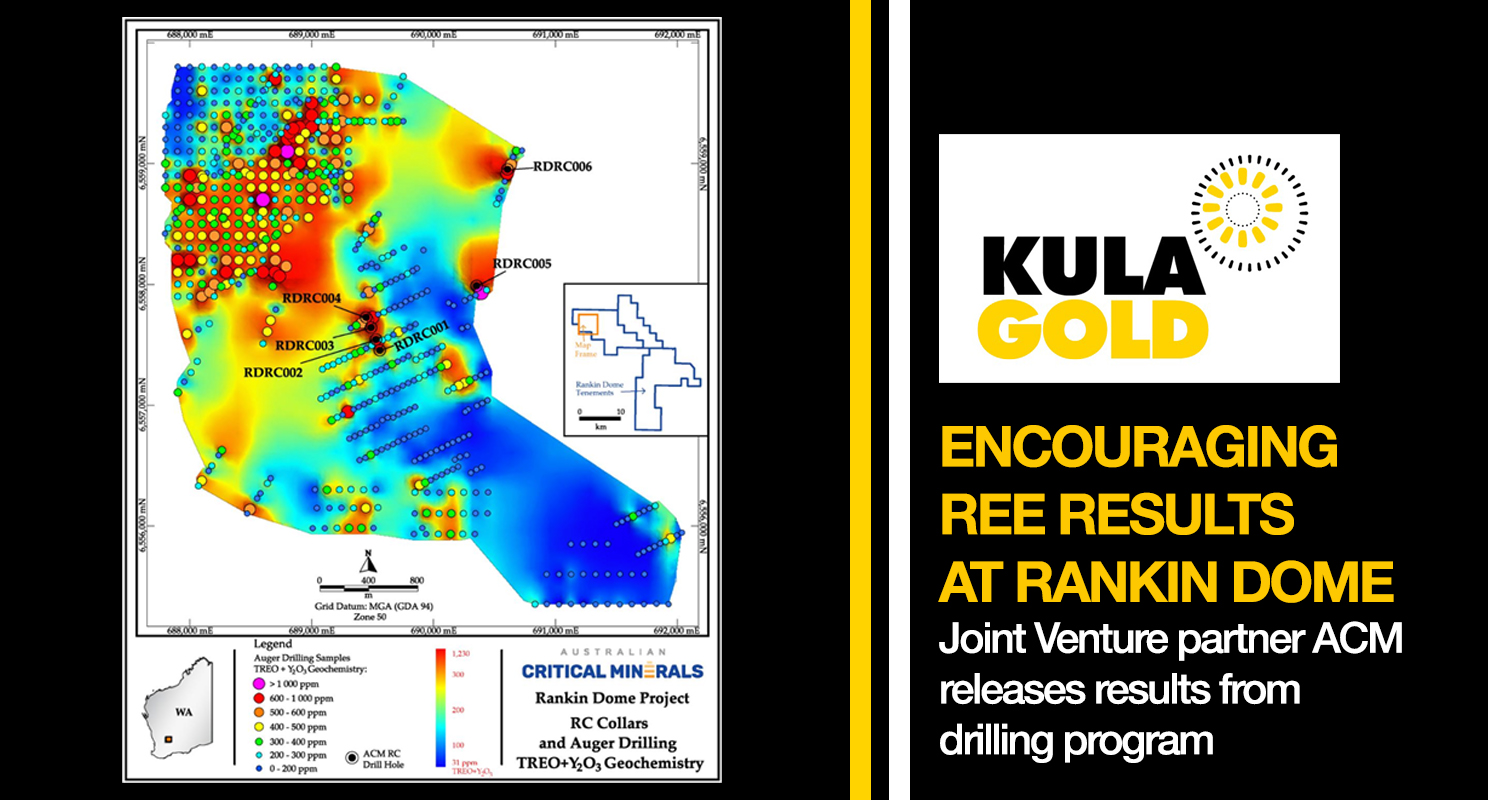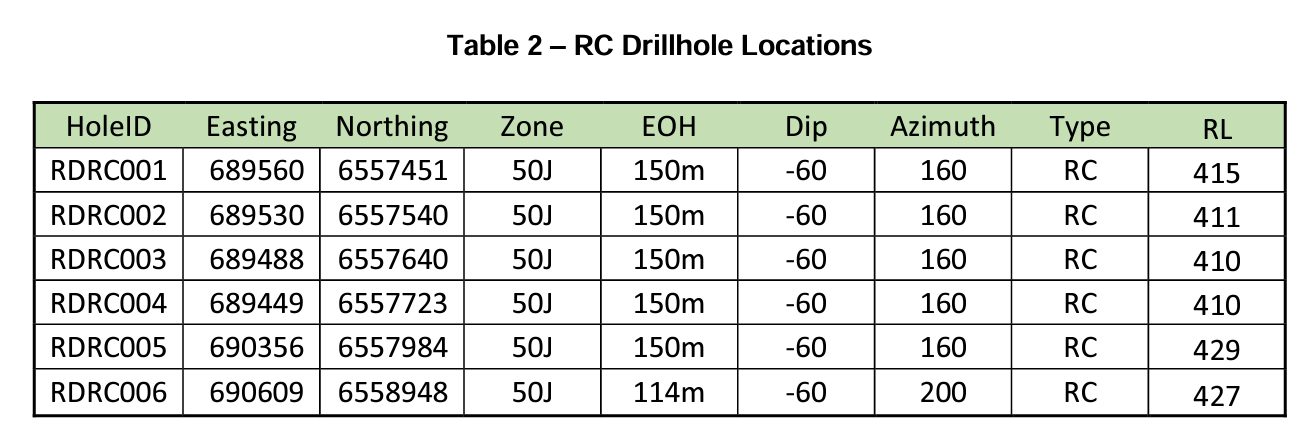
Kula Gold Managing Director Ric Dawson said:
“We are encouraged by the early success from ACM at the joint venture Rankin Dome REE Project near Southern Cross.”
HIGHLIGHTS – from ACM ASX Announcement.
- Thick intrusive hosted rare earth mineralisation across the Rankin Dome maiden drilling program
- 132 of 258 shallow auger samples returned significant assay results up to 1365ppm TREO
- All six RC drillholes returned thick continuous high-grade TREO (total rare earth oxides) with several ending in mineralisation
- 100% of drillholes have intervals greater than 1000ppm TREO with highlights including: o Grades up to 2534 ppm TREO; o Longest intercept of 111m at 913ppm TREO from 3m; and o Highest multiple-metre intercept of 3m at 2026 ppm TREO from 12m in RDRC001
- Magnetic rare earths (Pr, Nd, Tb, Dy) comprise 20% to 26% of significant result intervals
- Maiden RC drilling program clearly defines new drill targets with the anomaly open to the north and south
ACM Managing Director, Dean de Largie said:
“These outstanding results from ACM’s maiden drilling program confirm the prospectivity on the Rankin Dome Project. Significantly the magnetic rare earths consistently make up 20% to 27% of the TREO intervals. The high-definition auger sampling brings great clarity to the NW sector.
The substantial consistent strike lengths of highly anomalous near surface geochemistry in the auger area and consistent anomalous grades returned from the RC drilling is a significant result over a broad area and validates the approach taken by the Company. We are continuing our exploration activity at Rankin Dome.”
Auger Sampling
ACM completed a 254-hole high-definition auger sampling program over approximately 2.5 sq. km which has clearly delineated a substantial rare earth anomaly (Figure1). The auger anomaly is based on values above 500ppm TREO.
The spatial definition of the anomaly is sufficient for ACM to progress to planning RC drilling in co-ordination with the local landowner. Figure 1 shows very clearly a 500m by 200m zone of strongly anomalous rare earth element geochemistry. A peak of 1297 TREO (Total rare earth oxides) was returned. Of the 258 samples from a depth of 2m, 132 returned greater that 300ppm TREO.
The purpose of the auger sampling was to provide further geochemical definition over the area sampled previously by Kula Gold Limited and to provide further information on the depth of saprolite profile. 1 in 10 auger holes were drilled to auger refusal which occurred generally between 5 m and 9 m. Logs indicate saprolite remained present at auger refusal and thus it is expected that the saprolitic horizon continues deeper than auger refusal at this location.
About Rankin Dome
The Rankin Dome Project consists of three exploration licences in the Youanmi Terrane (Southern Cross). ACM has a farm-in agreement with Kula Gold Limited (ASX: KGD) to earn a 51% joint venture interest.
Reverse Circulation Drilling
A 6-hole reverse circulation drilling program was completed for 864m. Five drillholes were drilled to 150m and the remaining drillhole was drilled to 114m. The drillholes were planned over areas identified by Kula Gold Limited as having anomalous rare earth geochemistry in shallow auger samples that appeared to be coincident with aeromagnetic anomalies (Figure 2).
All six drillholes returned thick, continuous and significant results in total rare earth oxides and importantly the significant TREO intercepts which comprised between 20% and 26% magnetic rare earth oxides.

Figure 1 – Rankin Dome tREE raster of 2m auger geochemistry with overlying thematic of assay results, Yilgarn, Western Australia.
Figure 2 is a raster image of combined ACM and Kula Gold auger results. The location of the RC drillholes were based on the historic auger results combined with field observations and interpretations relating to topographic expression, observation of float rock on the surface and surrounding local geology.
FIGURE 3
The drill section of Figure 3 shows enhanced rare earth results were often associated with a rock of granodioritic composition. This was not ubiquitous as RDRC001 encountered significant mineralisation in the lower 50m of the drillhole in a monzogranite.
The section also shows that mineralisation was enhanced in the saprolitic clays and oxidised intrusive rock in the upper 30m. This alludes to supergene enrichment processes which have remobilised the rare earths from the lower levels water table movement to the upper near surface environment. This pattern of near surface enrichment above a depleted zone which sits itself above mineralised rock is common in Archaean gold deposits. It opens up possibilities of greater depth extents than early exploration and development indicated. Most drillholes ended in mineralisation and some with substantial grades.
All the RC drill holes returned intercepts of +1000ppm TREO. The best individual result was 1m at 2534 ppm TREO within a near-surface interval of 5m at 1641ppm TREO in Hole RDRC001. The best multiple metre intercept was 3m at 2012 ppm TREO in hole RDRC002. The longest significant intercept was 111m at 927ppm TREO in drillhole RDRC006 from 3m to end of hole at 114m. Both drillholes RDRC001 and RDRC006 terminate in strong rare earth anomalous geochemistry.
The drill section of drillhole RDRV001 to RDRC004 displays multiple thick mineralised intervals separated by less mineralised intervals. One kilometre east, Drillhole RDRC005 is most mineralised in the upper 60m one-kilometre northeast Drillhole RDRC006 is mineralised from near surface to the end of the drillhole at a depth of 114m (Figure 4 and Figure 5)
The ratio of LREO: to HREO varies between 4 and 13 (Table 1). There are significant values associated with the near surface clays and the oxidised intrusive rocks and also further down each drillhole associated with granodiorite and to a lesser degree the monzogranitic rocks. This manifestation is indicative of supergene enrichment and further indicates the source of the rare earths in the near surface clays is the intrusive rocks beneath. Intercepts reported are down-hole intercepts and true widths are unknown. There are two intrusive rock types present, monzogranite and granodiorite. Both are mineralised however mineralisation in the granodiorite tends to be of a higher tenor.
Future Works
The area between the RC drillholes and the strongly anomalous auger holes covers approximately 2.8 km2 (Figure 2). The results of the drill fence formed by drillholes 1 – 4 (Figure 3) indicate that the rare earth anomaly is open to the west and north of the drill-fence RDRC001 to 004. Drillhole RDRC005 and RD00g both warrant follow up drilling north and south of each of these two drillholes.
RC drilling will be planned to extend the current RC drill coverage to the north and south and to test the TREO delineated by the auger sampling program. This will be extended to include the area covered by the auger sampling program.
The Rankin Dome Project comprises three tenements and the exploration of the other tenements is currently in progress. The Company has an agreement with Kula Gold Limited (ASX: KGD) to earn a 51% interest in the Project.
Competent Person Statement
The information in this report that relates to Exploration Targets and Exploration Results is based on information compiled by Mr. Dean de Largie. Mr. de Largie is the Managing Director of Australian Critical Minerals Limited and is a Fellow of the Australian Institute of Geoscientists and has sufficient experience relevant to the styles of mineralisation under consideration and to the activity being reported to qualify as a Competent Person as defined in the 2012 Edition of the Australasian Code for Reporting of Exploration Results, Mineral Resources and Ore Reserves. Mr. de Largie have verified the data disclosed in this release and consent to the inclusion in this release of the matters based on the information in the form and context in which it appears.
News Release
Date: 4 December 2023 | ASX Code: KGD
About the Company
Kula Gold Limited (ASX: KGD) is a Western Australian mineral exploration company with expertise in the discovery of new mineral deposits in WA. The strategy is via large land positions and structural geological settings capable of hosting ~+1m oz gold or equivalent sized deposits including Lithium.
The Company is advancing projects within the South West region of WA for Lithium and Gold at Kirup and Brunswick – near the world class Greenbushes Lithium Mine, as well Lithium at the Taliah-Nadia-Sasha Prospects in the WA goldfields at Southern Cross, and Gold and PGE at Westonia (adjacent to the producing Edna May Gold Mine – owned by ASX:RMS).
Kula discovered the large 93.3mt Boomerang Kaolin deposit near Southern Cross WA – Maiden resource announced 20 July 2022. This project is in the economic study phase and moving to PE funding or trade JV.
The Company has a history of large resource discoveries with its foundation being the Woodlark Island Gold project in PNG, (+1m oz Gold) which was subsequently joint ventured and sold to (ASX: GPR).
Contact the Company Secretary for more information – +61(08) 6144 0592 or cosec@kulagold.com.au












